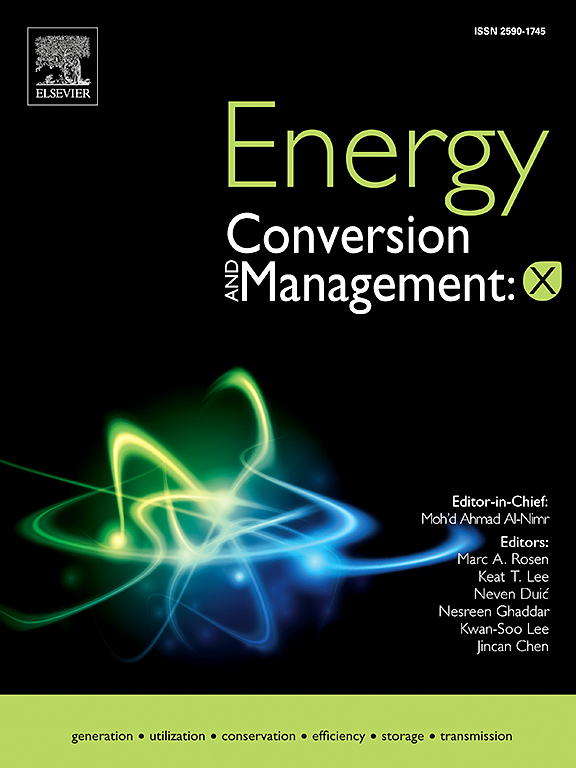Cooling and power generation performance evaluation of thermophotovoltaic system for hypersonic vehicle engines
IF 9.9
1区 工程技术
Q1 ENERGY & FUELS
引用次数: 0
Abstract
The development of hypersonic vehicles is challenging owing to their high cooling and power demands. To address this challenge, this paper proposes a thermophotovoltaic power-generation system for hypersonic vehicle engines that can generate power while providing thermal protection. Thermophotovoltaic cells are installed on the wall of the combustor cooling channels, through which the fuel flows to cool the cells. The photons emitted by the high-temperature emitter are filtered through a filter and reach the cell to generate electricity. A heat transfer and power generation model, including the combustor, thermophotovoltaics, and cooling channels, was established and iteratively solved until energy conservation was satisfied. The impact of different incoming Mach numbers, fuel flow rates, inlet temperatures, and starting positions on the cooling and power generation performance of the system was analyzed. The proposed thermophotovoltaic power-generation system reduced the weight of the combustor by 2.43 % at a combustor length of 3.12 m. The heat flux on the combustor wall in the section where thermophotovoltaics are arranged can be reduced by nearly 2/3, with the total thermal protection demand reduced by about 1 MW at Ma 7. The peak of the power generation density curve reached 58 kW/m2, generating 175.75 kW of electricity at Ma6 incoming flow, a 6 kg/s fuel flow rate, and a 263.15 K fuel inlet temperature. The power-to-weight ratio was 0.88, and the net heat-to-power conversion efficiency of the system reached 10.5 %. This research provides a reference for heat-to-power conversion technology of hypersonic vehicles at high flight Mach numbers.

高超声速飞行器发动机热光伏系统冷却与发电性能评价
高超声速飞行器由于其高冷却和功率需求而具有挑战性。为了解决这一挑战,本文提出了一种用于高超音速飞行器发动机的热光伏发电系统,该系统可以在提供热保护的同时发电。热光伏电池安装在燃烧室冷却通道的壁上,燃料流经该通道冷却电池。高温发射器发射的光子通过过滤器过滤后到达电池产生电力。建立包括燃烧室、热光伏、冷却通道在内的传热发电模型,迭代求解,直至满足节能要求。分析了不同来流马赫数、燃油流量、进口温度和起动位置对系统冷却和发电性能的影响。所提出的热光伏发电系统在燃烧器长度为3.12 m时,燃烧器的重量减少了2.43%。布置热光伏段燃烧室壁面热流密度可降低近2/3,总热防护需求在马安7时可降低约1 MW。发电密度曲线峰值达到58 kW/m2,在进料流量为Ma6、燃油流量为6 kg/s、燃油进口温度为263.15 K时,发电量为175.75 kW。功率重量比为0.88,系统的净热电转换效率达到10.5%。该研究为高超声速飞行器高飞行马赫数热功率转换技术提供了参考。
本文章由计算机程序翻译,如有差异,请以英文原文为准。
求助全文
约1分钟内获得全文
求助全文
来源期刊

Energy Conversion and Management
工程技术-力学
CiteScore
19.00
自引率
11.50%
发文量
1304
审稿时长
17 days
期刊介绍:
The journal Energy Conversion and Management provides a forum for publishing original contributions and comprehensive technical review articles of interdisciplinary and original research on all important energy topics.
The topics considered include energy generation, utilization, conversion, storage, transmission, conservation, management and sustainability. These topics typically involve various types of energy such as mechanical, thermal, nuclear, chemical, electromagnetic, magnetic and electric. These energy types cover all known energy resources, including renewable resources (e.g., solar, bio, hydro, wind, geothermal and ocean energy), fossil fuels and nuclear resources.
 求助内容:
求助内容: 应助结果提醒方式:
应助结果提醒方式:


